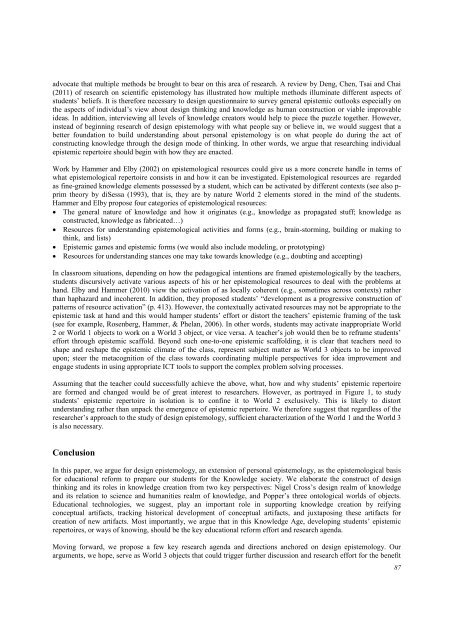Download Complete Issue in PDF - Educational Technology & Society
Download Complete Issue in PDF - Educational Technology & Society
Download Complete Issue in PDF - Educational Technology & Society
You also want an ePaper? Increase the reach of your titles
YUMPU automatically turns print PDFs into web optimized ePapers that Google loves.
advocate that multiple methods be brought to bear on this area of research. A review by Deng, Chen, Tsai and Chai<br />
(2011) of research on scientific epistemology has illustrated how multiple methods illum<strong>in</strong>ate different aspects of<br />
students’ beliefs. It is therefore necessary to design questionnaire to survey general epistemic outlooks especially on<br />
the aspects of <strong>in</strong>dividual’s view about design th<strong>in</strong>k<strong>in</strong>g and knowledge as human construction or viable improvable<br />
ideas. In addition, <strong>in</strong>terview<strong>in</strong>g all levels of knowledge creators would help to piece the puzzle together. However,<br />
<strong>in</strong>stead of beg<strong>in</strong>n<strong>in</strong>g research of design epistemology with what people say or believe <strong>in</strong>, we would suggest that a<br />
better foundation to build understand<strong>in</strong>g about personal epistemology is on what people do dur<strong>in</strong>g the act of<br />
construct<strong>in</strong>g knowledge through the design mode of th<strong>in</strong>k<strong>in</strong>g. In other words, we argue that research<strong>in</strong>g <strong>in</strong>dividual<br />
epistemic repertoire should beg<strong>in</strong> with how they are enacted.<br />
Work by Hammer and Elby (2002) on epistemological resources could give us a more concrete handle <strong>in</strong> terms of<br />
what epistemological repertoire consists <strong>in</strong> and how it can be <strong>in</strong>vestigated. Epistemological resources are regarded<br />
as f<strong>in</strong>e-gra<strong>in</strong>ed knowledge elements possessed by a student, which can be activated by different contexts (see also pprim<br />
theory by diSessa (1993), that is, they are by nature World 2 elements stored <strong>in</strong> the m<strong>in</strong>d of the students.<br />
Hammer and Elby propose four categories of epistemological resources:<br />
• The general nature of knowledge and how it orig<strong>in</strong>ates (e.g., knowledge as propagated stuff; knowledge as<br />
constructed, knowledge as fabricated…)<br />
• Resources for understand<strong>in</strong>g epistemological activities and forms (e.g., bra<strong>in</strong>-storm<strong>in</strong>g, build<strong>in</strong>g or mak<strong>in</strong>g to<br />
th<strong>in</strong>k, and lists)<br />
• Epistemic games and epistemic forms (we would also <strong>in</strong>clude model<strong>in</strong>g, or prototyp<strong>in</strong>g)<br />
• Resources for understand<strong>in</strong>g stances one may take towards knowledge (e.g., doubt<strong>in</strong>g and accept<strong>in</strong>g)<br />
In classroom situations, depend<strong>in</strong>g on how the pedagogical <strong>in</strong>tentions are framed epistemologically by the teachers,<br />
students discursively activate various aspects of his or her epistemological resources to deal with the problems at<br />
hand. Elby and Hammer (2010) view the activation of as locally coherent (e.g., sometimes across contexts) rather<br />
than haphazard and <strong>in</strong>coherent. In addition, they proposed students’ “development as a progressive construction of<br />
patterns of resource activation” (p. 413). However, the contextually activated resources may not be appropriate to the<br />
epistemic task at hand and this would hamper students’ effort or distort the teachers’ epistemic fram<strong>in</strong>g of the task<br />
(see for example, Rosenberg, Hammer, & Phelan, 2006). In other words, students may activate <strong>in</strong>appropriate World<br />
2 or World 1 objects to work on a World 3 object, or vice versa. A teacher’s job would then be to reframe students’<br />
effort through epistemic scaffold. Beyond such one-to-one epistemic scaffold<strong>in</strong>g, it is clear that teachers need to<br />
shape and reshape the epistemic climate of the class, represent subject matter as World 3 objects to be improved<br />
upon; steer the metacognition of the class towards coord<strong>in</strong>at<strong>in</strong>g multiple perspectives for idea improvement and<br />
engage students <strong>in</strong> us<strong>in</strong>g appropriate ICT tools to support the complex problem solv<strong>in</strong>g processes.<br />
Assum<strong>in</strong>g that the teacher could successfully achieve the above, what, how and why students’ epistemic repertoire<br />
are formed and changed would be of great <strong>in</strong>terest to researchers. However, as portrayed <strong>in</strong> Figure 1, to study<br />
students’ epistemic repertoire <strong>in</strong> isolation is to conf<strong>in</strong>e it to World 2 exclusively. This is likely to distort<br />
understand<strong>in</strong>g rather than unpack the emergence of epistemic repertoire. We therefore suggest that regardless of the<br />
researcher’s approach to the study of design epistemology, sufficient characterization of the World 1 and the World 3<br />
is also necessary.<br />
Conclusion<br />
In this paper, we argue for design epistemology, an extension of personal epistemology, as the epistemological basis<br />
for educational reform to prepare our students for the Knowledge society. We elaborate the construct of design<br />
th<strong>in</strong>k<strong>in</strong>g and its roles <strong>in</strong> knowledge creation from two key perspectives: Nigel Cross’s design realm of knowledge<br />
and its relation to science and humanities realm of knowledge, and Popper’s three ontological worlds of objects.<br />
<strong>Educational</strong> technologies, we suggest, play an important role <strong>in</strong> support<strong>in</strong>g knowledge creation by reify<strong>in</strong>g<br />
conceptual artifacts, track<strong>in</strong>g historical development of conceptual artifacts, and juxtapos<strong>in</strong>g these artifacts for<br />
creation of new artifacts. Most importantly, we argue that <strong>in</strong> this Knowledge Age, develop<strong>in</strong>g students’ epistemic<br />
repertoires, or ways of know<strong>in</strong>g, should be the key educational reform effort and research agenda.<br />
Mov<strong>in</strong>g forward, we propose a few key research agenda and directions anchored on design epistemology. Our<br />
arguments, we hope, serve as World 3 objects that could trigger further discussion and research effort for the benefit<br />
87

















